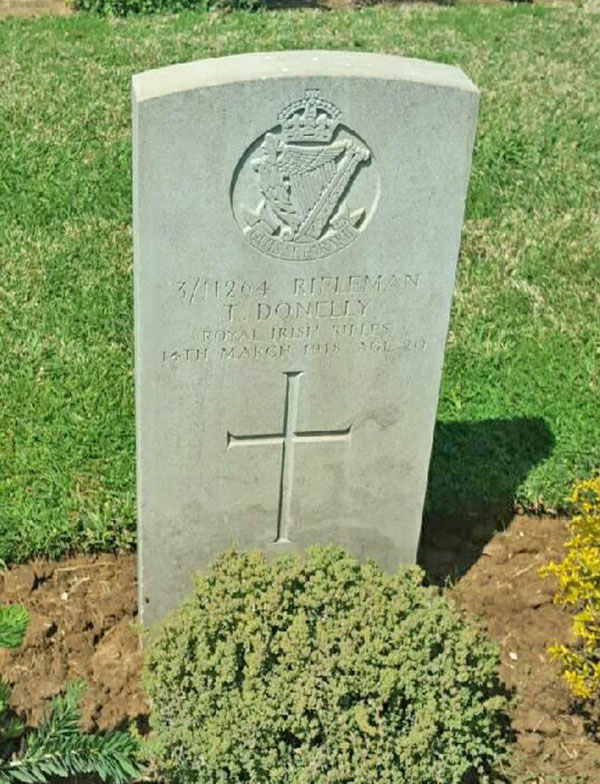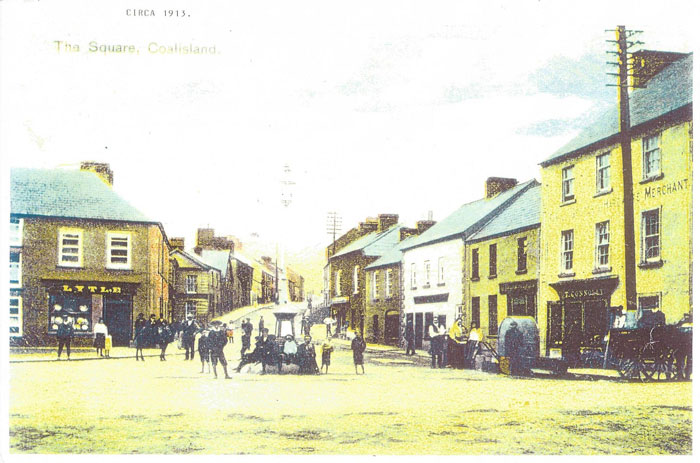| Date |
Information |
|
| 21/02/2021 |
Rifleman Thomas Donnelly is buried in Ramleh War Cemetery in Rabat in Israel. His inscription reads simply R.I.P. |
| 21/02/2021 |
Thomas was born on 15th November 1897 in Clonoe, County Tyrone. He was the eldest of three children. His two sisters died young. |
| 21/02/2021 |
The 1901 census shows his father to be a 27 year old coal-miner. Thomas was 4 years old. He had a younger sister, born about 1899. They were living in Annagher, Meenagh, Tyrone. |
| 21/02/2021 |
Family: John Donnelly, Mary Jane Donnelly, Thomas Donnelly (born 15th November 1897), Mary Eliza Donnelly (born 2nd January 1900, died 8th June 1905, age 5), Sarah Donnelly (born 15th July 1903, died 7th December 1903). |
| 21/02/2021 |
Rifleman Thomas Donnelly was serving with "C" Company of the 6th Battalion of the Royal Irish Rifles when he was killed in action in the Middle East on 14th March 1918. He was 20 years old. |
| 21/02/2021 |
 |
| 21/02/2021 |
Rifleman Thomas Donnelly is commemorated locally on Dungannon War Memorial. |
| 21/02/2021 |
The CWGC record Rifleman Thomas Donnelly as the son of John and Mary Jane Donnelly of Gortnashra, Coalisland, County Tyrone. |
| 21/02/2021 |
The 6th Battalion of the Royal Irish Rifles began the month of March 1918 as 29 Brigade's reserve battalion during the 10th (Irish) Division’s pursuit of the Turks across the Judean Hills. The advance was over difficult and arduous terrain. The battalion moved forward to lead the advance as the Turks took a stand in an area known as Hill 30. Turkish artillery and machine-gun fire disrupted the Rifle’s attacks, especially from the machine guns sited in enfilade positions. It was difficult to engage such a target with artillery fire as shells could not, due to a low flight trajectory, be dropped into these enfiladed positions. Modern warfare would deploy a highly mobile medium or light mortar with its high trajectory capable of dropping a bomb into a steep-sided feature (such as a wadi river bed). |
| 21/02/2021 |
Any advance was achieved by a series of short rushes and a tenacity to defend against Turkish counter attacks. Leadership by courage was displayed, especially by the officers of B Company, constantly moving forward and exposed to the enemy, as the company crept on beyond its flanking support. Such was the proximity to the enemy that any movement by the Company’s Runners (messengers) also attracted accurate and deadly rifle fire. |
| 21/02/2021 |
Eventually, after several days of action, the forward recce discovered that the Turks had withdrawn. The battalion advanced and occupied Hill 30. The Turkish artillery shelled the feature heavily on 12th March and as the battalion patrolled forward they discovered that the Turks chose not to occupy set defensive positions but rather to skirmish in strength and attack the battalion's advance posts at night. |
| 21/02/2021 |
The battalion was relieved on 20th March 1918. |
| 21/02/2021 |
By the time of the 1911 census, the family had moved to Coalisland Town. His father’s occupation was now a car driver. Thomas was now a 13 year old scholar. He could speak both Irish and English. |
| 20/02/2021 |
Thomas Donnelly was the only son of John and Mary Jane Donnelly. John Donnelly and Mary McGrath were married on 9th January 1897 in the district of Dungannon. |
| 28/05/2020 |
02436 |
| 30/12/2015 |
Thomas Donnelly enlisted in Dublin. |
| 30/12/2015 |
 |